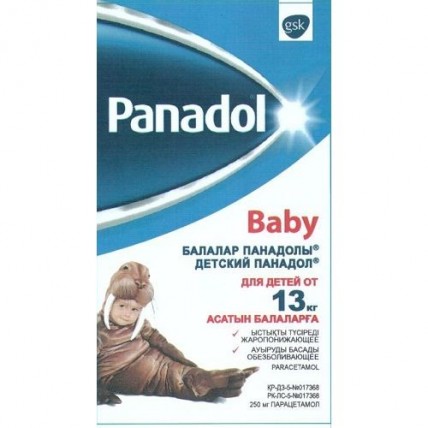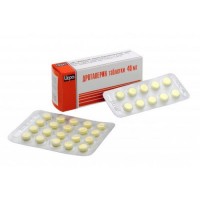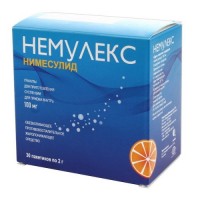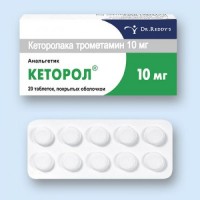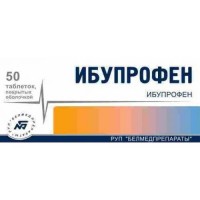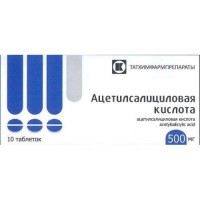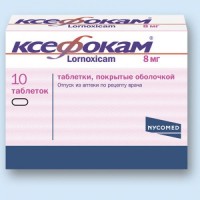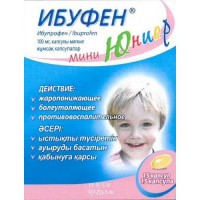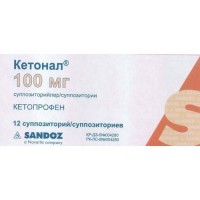Panadol 250 mg rectal suppositories 10s
- $8.80
The instruction for medical use
of PANADOL® CHILDREN'S medicine
the Trade name
Children's Panadol®
the International unlicensed
name Paracetamol Dosage Form
Suppositories rectal, 250 mg
Structure
One suppository contains
active agent - paracetamol of 250 mg,
excipient - solid fat.
The description
the White or almost white uniform suppositories of a cone-shaped form which do not have physical defects and visible impregnations.
Pharmacotherapeutic group
Analgetics. Other analgetics-antipyretics. Anilides. Paracetamol.
ATX N02BE01 code
Pharmacological
Pharmacokinetics Absorption properties high. After rectal administration 68-88% of paracetamol are soaked up. Communication with proteins of plasma about 15%. The peak of concentration in plasma is reached in 30–60 minutes.
Distribution of paracetamol in organism liquids rather evenly.
It is metabolized mainly in a liver with formation of several metabolites. Newborns of the first two days have lives and at children of 3-10 years the main metabolite of paracetamol is paracetamol sulfate, children have 12 years and are more senior - the conjugated glucuronide. A part of drug (about 17%) is exposed to hydroxylation with formation of active metabolites which conjugate with glutathione. At a lack of glutathione these metabolites of paracetamol can block the fermental systems of hepatocytes and cause their necrosis.
Elimination half-life at reception of a therapeutic dose makes 2-3 hours.
At reception of therapeutic doses of 90-100% of the accepted dose it is allocated with urine within one day. The main amount of drug is distinguished after conjugation in a liver. In not changed look no more than 3% of the received paracetamol dose are allocated.
The pharmacodynamics
Drug possesses anesthetic and febrifugal properties. Blocks cyclooxygenase in the central nervous system, influencing the centers of pain and thermal control. The febrifugal effect is connected with disturbance of synthesis of prostaglandins and reduction of their pyrogenous action by the center of thermal control located in a hypothalamus. Decrease in body temperature happens at the expense of a thermolysis, at a normotermiya the body temperature does not change as paracetamol belongs to not selective inhibitors of cyclooxygenase. The anti-inflammatory effect is practically absent. Digestive tract and water salt metabolism as does not influence synthesis of prostaglandins in peripheral fabrics does not influence a state mucous.
Indications
Children's Panadol® suppositories on 250 mg are applied at children from 2 to 7 years (with the body weight from 13 to 20 kg)
Is applied to symptomatic treatment of pain of weak and moderate degree and/or fever.
The route of administration and doses
use Drug rektalno. Wash up hands and release a suppository from a plastic cover. Accurately enter a suppository a forefinger into an anus of the child (preferably after a cleansing enema or spontaneous bowel emptying). It will be easier to enter at position of the child on one side with one leg tightened to a stomach.
The average single dose of Children's Panadola® in suppositories depends on the body weight of the child and makes 10-15 mg/kg of body weight 3-4 times a day every 4-6 hours. The maximum daily dose should not exceed 60 mg/kg of body weight.
To children with the body weight from 13 to 20 kg (usually from 2 to 7 years) 3-4 times a day in 4-6 hours enter on 1 candle (250 mg). It is not necessary to apply more than 4 candles a day in connection with risk of local toxicity. An interval between receptions – not less than 4 hours.
In a renal failure (the clearance of creatinine less than 10 ml/min. an interval between receptions has to be not less than 8 hours).
Not to accept along with others paracetamol - the containing drugs.
More than 3 days without appointment and observation of the doctor are not recommended to take the drug.
Not to exceed the recommended dose. In the absence of therapeutic effect it is necessary to stop treatment and to see the attending physician.
Side effects
Very seldom (& lt, 1/10,000)
- an anaphylaxis, reactions of hypersensitivity, including skin rash, a Quincke's disease, Stephens-Johnson's syndrome
- thrombocytopenia
- a bronchospasm at patients with hypersensitivity to acetylsalicylic acid and other NPVP (It is not necessary to take the drug if earlier disturbances of breath at intake of acetylsalicylic acid or non-steroidal anti-inflammatory drugs were observed)
- an abnormal liver function
- locally: irritation
It is necessary to stop immediately reception drug and to see a doctor at emergence of above-mentioned side reactions and also at emergence of peeling on skin, formation of sores in an oral cavity, difficulties of breath, hypostasis of lips, language, a throat and a face, hematomas, bleeding or any other undesirable reaction to drug.
Contraindications
- hypersensitivity to paracetamol or any other ingredient of drug
- recent inflammation or bleeding in a rectum (the contraindication connected with way of introduction), diarrhea
- heavy abnormal liver functions and kidneys
- blood diseases
- children's age up to 2 years
Medicinal interactions
Drug at reception enhances effect of indirect anticoagulants (warfarin and other coumarins) for a long time that increases risk of bleedings, single doses have no significant effect.
Paracetamol can distort test results on definition of uric acid and also glucose in blood.
Paracetamol - the containing drugs is not recommended to accept special instructions along with others.
Before administration of drug it is necessary to consult with the doctor:
- to patients with chronic diseases of a liver (associated diseases of a liver increase risk of injury of a liver at intake of paracetamol)
- to patients with chronic diseases of kidneys
- to the patients taking warfarin or other drugs for blood fluidifying
- in case the headache becomes a constant
- to patients in the presence of states which are followed by decrease in level of glutathione (for example, with heavy infections, such as sepsis) that can increase risk of developing of a metabolic acidosis.
Symptoms of a metabolic acidosis are the deep, speeded-up or complicated breath, nausea, vomiting, loss of appetite.
It is necessary to see immediately a doctor in case of these symptoms.
Overdose
in case of exceeding the recommended dose it is necessary to ask immediately for medical care, even at good health as there is a risk of the delayed serious injury of a liver.
Reception of 5 and more grams of paracetamol can lead to damage of a liver at the patients having the following risk factors:
- long treatment by carbamazepine, phenobarbital, Phenytoinum, Primidonum, rifampicin, drugs of the St. John's wort which is made a hole or other drugs stimulating liver enzymes
- the states which are followed by decrease in level of glutathione (disturbances of food, a mucoviscidosis, HIV infection, starvation, exhaustion).
Symptoms of acute poisoning with paracetamol in the first 24 hours are nausea, vomiting, stomach aches, perspiration, pallor of integuments. Damage of a liver is defined in 12-48 hours after overdose.
There can be disturbances of metabolism of glucose and metabolic atsidozirovanny In a serious poisoning the liver failure can progress in encephalopathy, hemorrhages, a hypoglycemia, wet brain and a lethal outcome. The acute renal failure with acute necrosis of tubules can be shown by severe lumbar pain, a hamaturia, a proteinuria andeven in the absence of severe damage of a liver. Also cardiac arrhythmia and pancreatitis were noted.
Treatment: At overdose the immediate medical care is necessary. The patient should be taken immediately to hospital even if there are no early symptoms of overdose. Symptoms can be limited to nausea and vomiting or can not reflect weights of overdose or risk of defeat of bodies. Concentration of paracetamol in blood plasma should be defined not earlier than in 4 hours and even later after administration of drug (earlier definition of concentration is not reliable).
Treatment by N-Acetylcysteinum can be carried out within 24 hours after intake of paracetamol, however, perhaps to gain the maximum effect of this antidote at its use within 8 hours after reception. The efficiency of antidote sharply decreases after this time. If necessary N-Acetylcysteinum is entered to the patient intravenously according to the recommended doses. In the absence of vomiting the methionine use orally as an alternative is possible at impossibility of the emergency transportation of the patient in hospital.
The form of release and packing
On 5 suppositories place in blister strip packaging from a film of polyethylene polyvinylchloride varnished.
2 planimetric packs together with the instruction for medical use in the state and Russian languages place in a pack cardboard.
To Store storage conditions at a temperature not above +25 °C.
To store out of children's reach!
Do not use a period of storage of 5 years after the expiry date specified on packing.
Prescription status
Without prescription
the Name and the country
of the Pharmakler manufacturing organization, France.
The name and the country of the owner of the registration certificate
"GlaksoSmitKlyayn to Santa Gran Publik", France
the Address of the organization accepting in the territory of the Republic of Kazakhstan claims from consumers on quality of products (goods) of the GlaksoSmitKlyayn Export Ltd personal computer, Almaty, Furmanov St., 273. ph. +7 (727) 258-28-92, 244-69-99, fax +7 (727) 258-28-90 (automatic machine). E-mail:
kz.safety@gsk.com
of PANADOL® CHILDREN'S medicine
the Trade name
Children's Panadol®
the International unlicensed
name Paracetamol Dosage Form
Suppositories rectal, 250 mg
Structure
One suppository contains
active agent - paracetamol of 250 mg,
excipient - solid fat.
The description
the White or almost white uniform suppositories of a cone-shaped form which do not have physical defects and visible impregnations.
Pharmacotherapeutic group
Analgetics. Other analgetics-antipyretics. Anilides. Paracetamol.
ATX N02BE01 code
Pharmacological
Pharmacokinetics Absorption properties high. After rectal administration 68-88% of paracetamol are soaked up. Communication with proteins of plasma about 15%. The peak of concentration in plasma is reached in 30–60 minutes.
Distribution of paracetamol in organism liquids rather evenly.
It is metabolized mainly in a liver with formation of several metabolites. Newborns of the first two days have lives and at children of 3-10 years the main metabolite of paracetamol is paracetamol sulfate, children have 12 years and are more senior - the conjugated glucuronide. A part of drug (about 17%) is exposed to hydroxylation with formation of active metabolites which conjugate with glutathione. At a lack of glutathione these metabolites of paracetamol can block the fermental systems of hepatocytes and cause their necrosis.
Elimination half-life at reception of a therapeutic dose makes 2-3 hours.
At reception of therapeutic doses of 90-100% of the accepted dose it is allocated with urine within one day. The main amount of drug is distinguished after conjugation in a liver. In not changed look no more than 3% of the received paracetamol dose are allocated.
The pharmacodynamics
Drug possesses anesthetic and febrifugal properties. Blocks cyclooxygenase in the central nervous system, influencing the centers of pain and thermal control. The febrifugal effect is connected with disturbance of synthesis of prostaglandins and reduction of their pyrogenous action by the center of thermal control located in a hypothalamus. Decrease in body temperature happens at the expense of a thermolysis, at a normotermiya the body temperature does not change as paracetamol belongs to not selective inhibitors of cyclooxygenase. The anti-inflammatory effect is practically absent. Digestive tract and water salt metabolism as does not influence synthesis of prostaglandins in peripheral fabrics does not influence a state mucous.
Indications
Children's Panadol® suppositories on 250 mg are applied at children from 2 to 7 years (with the body weight from 13 to 20 kg)
Is applied to symptomatic treatment of pain of weak and moderate degree and/or fever.
The route of administration and doses
use Drug rektalno. Wash up hands and release a suppository from a plastic cover. Accurately enter a suppository a forefinger into an anus of the child (preferably after a cleansing enema or spontaneous bowel emptying). It will be easier to enter at position of the child on one side with one leg tightened to a stomach.
The average single dose of Children's Panadola® in suppositories depends on the body weight of the child and makes 10-15 mg/kg of body weight 3-4 times a day every 4-6 hours. The maximum daily dose should not exceed 60 mg/kg of body weight.
To children with the body weight from 13 to 20 kg (usually from 2 to 7 years) 3-4 times a day in 4-6 hours enter on 1 candle (250 mg). It is not necessary to apply more than 4 candles a day in connection with risk of local toxicity. An interval between receptions – not less than 4 hours.
In a renal failure (the clearance of creatinine less than 10 ml/min. an interval between receptions has to be not less than 8 hours).
Not to accept along with others paracetamol - the containing drugs.
More than 3 days without appointment and observation of the doctor are not recommended to take the drug.
Not to exceed the recommended dose. In the absence of therapeutic effect it is necessary to stop treatment and to see the attending physician.
Side effects
Very seldom (& lt, 1/10,000)
- an anaphylaxis, reactions of hypersensitivity, including skin rash, a Quincke's disease, Stephens-Johnson's syndrome
- thrombocytopenia
- a bronchospasm at patients with hypersensitivity to acetylsalicylic acid and other NPVP (It is not necessary to take the drug if earlier disturbances of breath at intake of acetylsalicylic acid or non-steroidal anti-inflammatory drugs were observed)
- an abnormal liver function
- locally: irritation
It is necessary to stop immediately reception drug and to see a doctor at emergence of above-mentioned side reactions and also at emergence of peeling on skin, formation of sores in an oral cavity, difficulties of breath, hypostasis of lips, language, a throat and a face, hematomas, bleeding or any other undesirable reaction to drug.
Contraindications
- hypersensitivity to paracetamol or any other ingredient of drug
- recent inflammation or bleeding in a rectum (the contraindication connected with way of introduction), diarrhea
- heavy abnormal liver functions and kidneys
- blood diseases
- children's age up to 2 years
Medicinal interactions
Drug at reception enhances effect of indirect anticoagulants (warfarin and other coumarins) for a long time that increases risk of bleedings, single doses have no significant effect.
Paracetamol can distort test results on definition of uric acid and also glucose in blood.
Paracetamol - the containing drugs is not recommended to accept special instructions along with others.
Before administration of drug it is necessary to consult with the doctor:
- to patients with chronic diseases of a liver (associated diseases of a liver increase risk of injury of a liver at intake of paracetamol)
- to patients with chronic diseases of kidneys
- to the patients taking warfarin or other drugs for blood fluidifying
- in case the headache becomes a constant
- to patients in the presence of states which are followed by decrease in level of glutathione (for example, with heavy infections, such as sepsis) that can increase risk of developing of a metabolic acidosis.
Symptoms of a metabolic acidosis are the deep, speeded-up or complicated breath, nausea, vomiting, loss of appetite.
It is necessary to see immediately a doctor in case of these symptoms.
Overdose
in case of exceeding the recommended dose it is necessary to ask immediately for medical care, even at good health as there is a risk of the delayed serious injury of a liver.
Reception of 5 and more grams of paracetamol can lead to damage of a liver at the patients having the following risk factors:
- long treatment by carbamazepine, phenobarbital, Phenytoinum, Primidonum, rifampicin, drugs of the St. John's wort which is made a hole or other drugs stimulating liver enzymes
- the states which are followed by decrease in level of glutathione (disturbances of food, a mucoviscidosis, HIV infection, starvation, exhaustion).
Symptoms of acute poisoning with paracetamol in the first 24 hours are nausea, vomiting, stomach aches, perspiration, pallor of integuments. Damage of a liver is defined in 12-48 hours after overdose.
There can be disturbances of metabolism of glucose and metabolic atsidozirovanny In a serious poisoning the liver failure can progress in encephalopathy, hemorrhages, a hypoglycemia, wet brain and a lethal outcome. The acute renal failure with acute necrosis of tubules can be shown by severe lumbar pain, a hamaturia, a proteinuria andeven in the absence of severe damage of a liver. Also cardiac arrhythmia and pancreatitis were noted.
Treatment: At overdose the immediate medical care is necessary. The patient should be taken immediately to hospital even if there are no early symptoms of overdose. Symptoms can be limited to nausea and vomiting or can not reflect weights of overdose or risk of defeat of bodies. Concentration of paracetamol in blood plasma should be defined not earlier than in 4 hours and even later after administration of drug (earlier definition of concentration is not reliable).
Treatment by N-Acetylcysteinum can be carried out within 24 hours after intake of paracetamol, however, perhaps to gain the maximum effect of this antidote at its use within 8 hours after reception. The efficiency of antidote sharply decreases after this time. If necessary N-Acetylcysteinum is entered to the patient intravenously according to the recommended doses. In the absence of vomiting the methionine use orally as an alternative is possible at impossibility of the emergency transportation of the patient in hospital.
The form of release and packing
On 5 suppositories place in blister strip packaging from a film of polyethylene polyvinylchloride varnished.
2 planimetric packs together with the instruction for medical use in the state and Russian languages place in a pack cardboard.
To Store storage conditions at a temperature not above +25 °C.
To store out of children's reach!
Do not use a period of storage of 5 years after the expiry date specified on packing.
Prescription status
Without prescription
the Name and the country
of the Pharmakler manufacturing organization, France.
The name and the country of the owner of the registration certificate
"GlaksoSmitKlyayn to Santa Gran Publik", France
the Address of the organization accepting in the territory of the Republic of Kazakhstan claims from consumers on quality of products (goods) of the GlaksoSmitKlyayn Export Ltd personal computer, Almaty, Furmanov St., 273. ph. +7 (727) 258-28-92, 244-69-99, fax +7 (727) 258-28-90 (automatic machine). E-mail:
kz.safety@gsk.com
